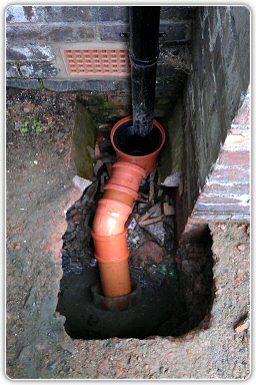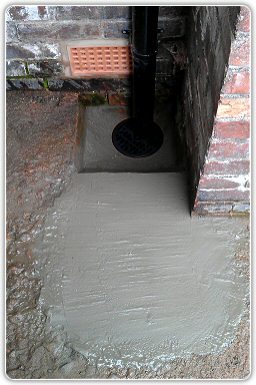


Renovation & Excavation
Often the costs for replacing a deep collapsed or root-infested drain can prove expensive, although there are other options.
Most cost-effective, and requiring little or no excavation, would be to "patch" the drain, rather than replacing it...
No-Dig Patching
Here, we'll take a look at this method of renovation, as well as one or two other methods of avoiding an excavation, although it has to be said - there are caveats with these patching methods, and depending on the circumstances, cost differences between renovation and excavation often even out somewhat; and let's face it, patching something is never as dependable as replacement.
So do ask for estimates and discuss the pros and cons with your Contractor.
Excavation, Repairs & Drainage Replacement

Although on occasion the most expensive form of repair, most engineers would prefer the installation of new drains for old - much like how you'd prefer any faulty household item to be handled. Depending on the circumstances of course, a new drain, installed correctly, should ensure no future problems. There are many reasons why other repair methods, such as Patch Lining and Drain Lining, may not offer the same results, and we'll cover this a little further down the page.
It is normally the case that when installing new underground drainage pipes, a camera survey would be beneficial prior to implementation. A survey, generally carried out in combination with sonar-location, would determine the location of the defect, the extent of the problem and also allow for a depth reading. All useful information required to supply an accurate quote rather than having your engineer guessing and submitting a less than accurate estimate.
Drainage repairs would include the installation of new gullies, pipes, inspection chambers, manholes, drainage channels (ACO), soak-aways, rainwater pipes, rodding access points and soil vent pipes or stack pipes, etc.
Drain Lining And Renovation
Drain Lining is a method of repairing an underground drain with minimal or no disruption. It involves installing a lining within the damaged pipe that when sets, effectively becomes a pipe within a pipe. However, for drain lining to be carried out with no disruption whatsoever, access points are very important, i.e. manholes, inspection chambers or rodding points. It's really not possible to install a drain liner without the necessary access points with which to carry out the work. And should the necessary access points not exist, either new access points would have to be installed or excavations would have to be carried out to facilitate the procedure.

Let it also be noted that for this technology to work problem free, the damage to the drain has to be minimal. For instance, a drain that has dropped, subsided and holding water, renovation may only serve to stop any further movement of the drain. It may not however halt any further or future movement of the ground around the drain. If cavities around the drain are present prior to the liner being installed, future ground movement will still occur. Also taking into account the afore-mentioned circumstances, it would be highly probable that a lined or renovated drain, still dropped and holding waste-water, would cause future blockages. It must be remembered that Drain Lining is not a "cure all" method of repair, and this is where an underground camera survey to assess the damage is all so important.
Patch Lining
A more localised version of the Drain Lining method, Patch Lining reaches approximately 60cm in length and is generally used in spot repair situations. For example, a single fractured drain or displaced pipe joint may benefit from a Patch Liner repair. Root infiltration at a pipe joint or through a fractured drain, could, after removal of the roots, be halted by the insertion of a Patch Liner. Though do be aware in the case of root infiltration, that once halted at one fault in your drainage system, roots will simply seek out the next breach, should there be one.
Although cost implications would have to be considered, including the design of the drainage system, there is no limit to the amount of Patch Liners that can be used in a drain. However, as with Drain Lining, the extent of damage to the drain should be assessed by camera prior to insertion of the liner. Perhaps should also be noted, that a Drain Liner or Patch Liner used to repair a drain with considerable damage, may possibly restrict flow and cause future periodic blockages, so do check whether Drain or Patch Lining is viable against the condition of the drain prior to proceding, and not just the easiest or Contractor's preferred option. If choosing renovation over replacement, for peace of mind, always remember to ask for a copy of any underground camera survey footage before works are undertaken and after the repairs have been implemented.
A Little Caution On Drain And Patch Lining?
Too often is it the case when drainage problems are diagnosed, that the preferred repair method is Drain Lining. What could be better, right? In most instances it may be considered the cheapest, least disruptive and the least inconvenient method of repair. However, for this method to be successful, and outside of "no other choice", the condition of the drain has to be such, that Drain Lining would be a complete cure and not leave any future associated problems.
When remedial works are carried out by an "Approved Contractor" appointed by a Insurance Claims Handler, a Drain Liner installation may invariably be seen as the preferred cheapest option. So do remember that lining a drain unsuitable for this method of renovation may possibly result in future, repeat blockages, which may even be the exact same symptoms experienced prior to the installation of the Drain Liner! If in doubt, ask for a survey prior to work being carried out - and should the defects within a drain be determined to be severe, excavation and replacement is often the only method that should be considered.